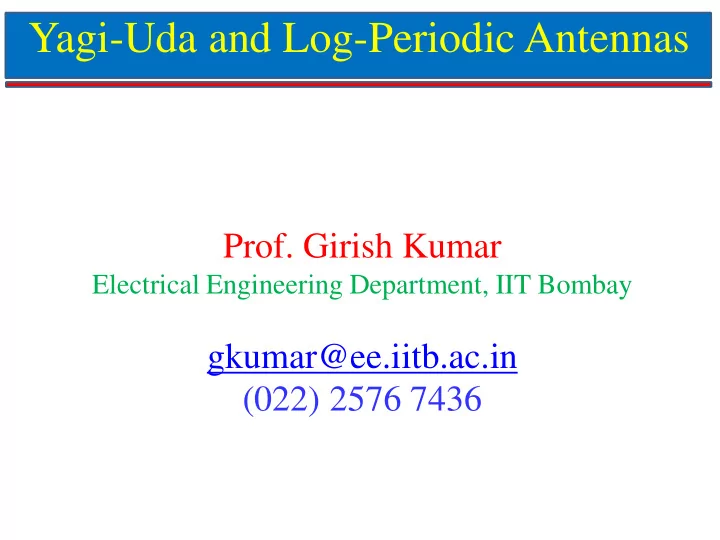

Yagi-Uda and Log-Periodic Antennas Prof. Girish Kumar Electrical Engineering Department, IIT Bombay gkumar@ee.iitb.ac.in (022) 2576 7436
Linear Dipole with a Reflector A linear dipole antenna has omni-directional radiation pattern. Gain ≈ 2 dB A dipole with a linear reflector has directional radiation pattern with gain ≈ 5 dB
Yagi-Uda Antenna with 3-Elements H-Plane Pattern E-Plane Pattern A 3-element Yagi-Uda Antenna has one fed dipole, one linear reflector and one director. Length of the dipole: l + d = 0.48 λ Length of the reflector > l > Length of the director Spacing between the elements ≈ λ /4 It acts as an end- fire array antenna. Gain ≈ 7 dB
General Yagi-Uda Antenna Reflector Driven dipole Directors
Typical Values of Yagi-Uda Antenna
Directivity vs No. of Elements Practically, Gain is around 1 dB less than this value. No. of Elements (N)
3-Element Printed Yagi-Uda Antenna 39 mm 32 mm Frequency: 1.3 GHz λ = 230 mm FR4 Substrate: ε r = 4.4, h = 1.6 mm ε eff ≈ 1.3 -1.4 due to field in air Length of Director = 72 mm 85 mm Length of Reflector Length of Driven = 102 mm Dipole = 91 mm
Results of 3-Element Yagi-Uda Antenna For |S 11 | < - 10 dB, Measured BW = 15.4% Measure Peak Gain = 6.3 dB
Radiation Pattern at 1.3 GHz xy Plane – E Plane xz Plane – H Plane
Broadband Planar Quasi-Yagi Antenna 3.3 mm 4.2 mm 3 mm 2.9 mm 16 mm 8.6 mm Bandwidth: 48% at X-band Gain: 3.4 - 5.1 dB 17.4 mm Substrate: ε r = 10.2 and h = 0.635 mm Another design given for lesser BW and larger Gain N. Kaneda, W. R. Deal, Yongxi Qian, R. Waterhouse and T. Itoh, "A broadband planar quasi-Yagi antenna," in IEEE Transactions on Antennas and Propagation , vol. 50, no. 8, pp. 1158-1160,Aug. 2002.
Simplified Feed for Printed Yagi Antenna Lref1 16 mm Ldir 2.84 mm Sref1 7.5 mm Sdir 2.58 mm Wm 0.6 mm Wdri 0.6 mm Wdir 0.6 mm Ldri1 4.23 mm BW = 40% at X-band G. Zheng, A. A. Kishk, A. W. Glisson and A. B. Yakovlev, "Simplified feed for modified printed Yagi antenna," in Electronics Letters , vol. 40, no. 8, pp. 464-466, 15 April 2004.
Broadband CPW-Fed Quasi-Yagi Antenna Sref 5.69 mm Ldir 3.73 mm L 19.2 mm W 29 mm Sdir1=Sdir2 0.96 mm Wdir1=Wdir2 0.96 mm L1 8.61 mm L2 7.61 mm Srd 9.69 mm Lri 11.5 mm Bandwidth = 44% at X-band Peak Gain = 7.4 dB H. K. Kan, R. B. Waterhouse, A. M. Abbosh and M. E. Bialkowski, "Simple Broadband Planar CPW-Fed Quasi-Yagi Antenna," in IEEE Antennas and Wireless Propagation Letters , vol. 6, pp. 18-20, 2007.
Log-Periodic Dipole Array Antenna All dipole elements are fed with successive elements out of phase. Radiates in end-fire direction.
LPDA Design Equations 1 1 2tan 4
LPDA Design Formulas U L L L N 1 2 2 λ L = c/f L , where f L is the λ U = c/f U , where f U is the lowest frequency of highest frequency of operation. operation. Add one large dipole, Add a few small dipoles which acts as reflector in front, which act as to increase gain at directors to increase gain lower frequencies. at higher frequencies.
Design Curve for LPDA for given Directivity Scaling Factor ( τ )
Design of LPDA Antenna Example: Design of a 54 to 216 MHz Log- periodic Dipole Antenna. Desired Gain: 6.5 dB Solution: For gain = 6.5 dB, optimum values of τ and σ are obtained from the design curve for Directivity = 7.5 dB (assuming 1 dB loss). So, τ = 0.822 and σ = 0.149. Therefore,
Design of LPDA Antenna (Contd.) Longest dipole length is calculated corresponding to lowest frequency = 54 MHz Shortest dipole length is calculated corresponding to highest frequency = 216 MHz
Design of LPDA Antenna (Contd.) Length of other elements is calculated by scaling the largest dipole length (2.78 m) until the smallest dipole length (0.694 m) is obtained. L 1 = 2.78 m, L 2 = 2.29 m, L 3 = 1.88 m, L 4 = 1.54 m, L 5 = 1.27 m, L 6 = 1.04 m, L 7 = 0.858 m, L 8 = 0.705 m, L 9 = 0.579 m. So, N = 9. One or two elements can be added at both the ends to improve the performance at the cut-off.
Design of LPDA Antenna (Contd.) The spacing between the elements is found from: Using dipole lengths, spacing between the elements is calculated as: d 1 = 0.828 m, d 2 = 0.682 m, d 3 = 0.560 m, d 4 = 0.459 m, d 5 = 0.378 m, d 6 = 0.310 m, d 7 = 0.256 m, d 8 = 0.210 m.
Results of LPDA for 54 to 806 MHz
HPBW of LPDA for 54 to 806 MHz
Printed LPDA using Co-axial Balun for 700 to 2500 MHz Half-Dipole on bottom of substrate Coaxial Cable 280 mm N = 20, τ = 0.89, and σ = 0.083 Half-Dipole on top of substrate σ is taken smaller than optimum value to reduce overall length of antenna
Simulated Gain of Printed LPDA
Measured |S 11 | of Printed LPDA For |S 11 | < - 9 dB, Measured BW: 0.64 to 3.74 GHz
Recommend
More recommend